|
The Motion C5 MCA platfrom
Motion presents a lightweight, semi-rugged Mobile Clinical Assistant
(by Conrad H. Blickenstorfer)
Please note that this article describes the original Motion C5 Mobile Clinical Assistant, first introduced in 2007. Since then, Motion added the F5 as a field-oriented version of the platform, and has been keeping both the C5 and the F5 meticulously up-to-date with several hardware upgrades. As of October 2015, the current versions are the C5m and F5m. However, the below article remains valid as it describes the background and implementation of the overall platform.
Motion Computing, ever the pioneer in innovative tablet computers, introduced the Motion C5 Mobile Clinical Assistant at the UCSF Medical Center in San Francisco on February 20, 2007. Motion developed this machine specifically for medical markets, with the goal to help nurses, doctors and clinical support staff to do their jobs on the move. The C5 is a lightweight, bump-tolerant, spill-resistant and
easy-to-disinfect tablet sealed to IP 54 specifications and powerful enough to run Microsoft's new Vista operating system.
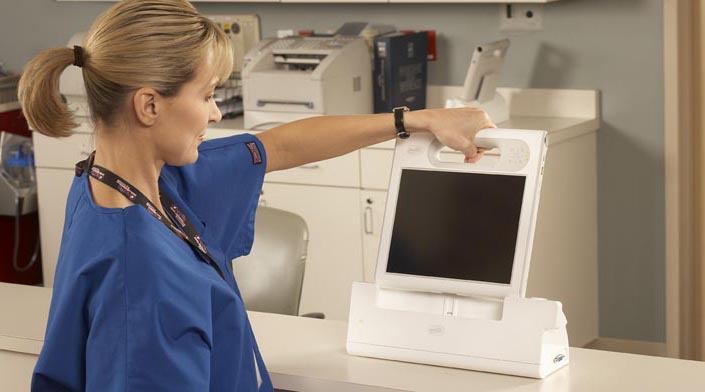
Tackling a tough vertical market
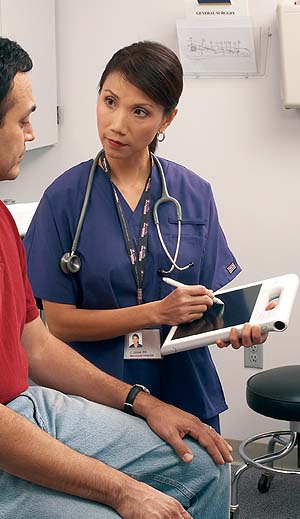 The C5 is a Tablet PC made by arguably the foremost designer and manufacturer of slate computers. That's what Motion Computing does, and nothing else. Just as it was gutsy of the then newly-formed company to take on the likes of Fujitsu when Microsoft announced the Tablet PC in late 2002, it's gutsy to introduce a brand-new slate product designed for just one vertical market. Reliance on any one market is always risky, and especially one as fickle as healthcare where politics, technical issues, incompatible systems, internal resistance, training requirements and long budget cycles can conspire to present frustrating hurdles. Then again, few markets need connected mobile technology more than healthcare, and that is what Motion is banking on with the C5. And as far as we're concerned, if anyone can pull it off, it's Motion Computing.
The C5 is a Tablet PC made by arguably the foremost designer and manufacturer of slate computers. That's what Motion Computing does, and nothing else. Just as it was gutsy of the then newly-formed company to take on the likes of Fujitsu when Microsoft announced the Tablet PC in late 2002, it's gutsy to introduce a brand-new slate product designed for just one vertical market. Reliance on any one market is always risky, and especially one as fickle as healthcare where politics, technical issues, incompatible systems, internal resistance, training requirements and long budget cycles can conspire to present frustrating hurdles. Then again, few markets need connected mobile technology more than healthcare, and that is what Motion is banking on with the C5. And as far as we're concerned, if anyone can pull it off, it's Motion Computing.
A Mobile Clinical Assistant
So what is the Motion C5 and what makes it a "Mobile Clinical Assistant"? We don't know if it's indeed a new computing category as Motion's press release suggests, nor whether the moniker will stick. People may just call it "the Motion" or "my Motion." The C5 is also not a new computing category as far as its technology goes. It is not some sort of thin client or webpad that requires a novel or unusual infrastructure. This is a standard Windows machine that doesn't require re-learning. It runs the Windows XP Tablet PC Edition or Windows Vista Business that has all the tablet functionality already built in. It's powered by a competent 1.2GHz Core Solo U1400 processor and uses the Intel 945GM Extreme Graphics controller. That's perhaps at the low end of what it takes to run Vista, but based on our experiences with Vista so far, the C5 should do just fine.
Even though the guts of the C5 are pure Tablet PC, it's clear that it was designed for a purpose. It'll be used indoors and won't take more physical punishment than the occasional bump or two, but Motion still gave it a tough magnesium-alloy frame, and a shape and body based on the input from thousands of clinicians worldwide. The result is a sleek, elegant slate with a ten by ten inch footprint. Its off-white body fits right into any medical environment, though it's also unusually elegant and less than an inch thick. It'll spend much of its time in its multi-function docking station, but it is easily removed. Weighing just over three pounds -- less than an ultralight notebook -- and equipped with a handle integrated right into the design, the C5 is easy to carry, hold, and use.
Motion designed the C5 with three goals in mind. First, to create a device specifically tailored to the needs of the healthcare environment. Second, to come up with something that would truly improve the productivity of clinicians. And third, to make the device secure. They accomplished this as follows:
Designed for the healthcare environment
Since healthcare environments depend on meticulous cleanliness and proper disinfection to prevent the spread of disease, the C5's elegant case is highly sealed and doesn't have a lot of ports that would make it difficult to clean. This way, it's easy to clean and wipe off. The outside is made of a chemical-resistant resin that can easily hold up to frequent cleaning. The C5's IP54 ingress protection rating is much more than one would expect from a device designed for indoor use, but it's certainly a wise move. The integrated handle makes it easy to carry the C5 around, which means it just may get dropped at times. That's why Motion built it around that magnesium-alloy frame, gave it a shock-mounted hard drive with either 30 or 60 gigabyte capacity, and a hardware accelerometer that quickly removes the disk head into a safe position if it detects a fall. This protects against data loss.
Since this machine won't be used out in the field or away from its dock for an extended period of time, Motion provided a battery that's powerful enough to run the C5 for three hours or so, but not one that would have made the device needlessly heavy. In case that the C5 is being used away from the dock for an extended period of time, there is a charging slot in the dock for a second battery.
The handy and elegant docking station can be mounted on countertops, walls or carts and tilt at three angles (15, 25, and 38 degrees). It has an RJ45 Ethernet jack for when the C5's internal 802.11a/b/g wireless radio cannot be used, as well as a video-out port and three USB ports for peripherals and such. The docking station is brilliantly conceived and executed, and exactly what's needed for the various mounting requirements in a clinical setting.
The C5's screen is a 10.4-inch XGA TFT with 1024 x 768 pixel resolution. It's a standard transmissive LCD since it'll be used indoors, but it's also available with "View Anywhere" technology for better readability in harsh lighting conditions.
Improving productivity
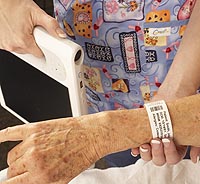 How does the C5 intend to improve productivity? Well, there's the inherent digital ink capability of a Tablet PC, which means it's easy to annotate, scribble, draw, or even use handwriting reco. There's also Motion's superb "Speak Anywhere" technology that uses a multi-directional array for dictation that can, after some practice, transcribe right into applications.
How does the C5 intend to improve productivity? Well, there's the inherent digital ink capability of a Tablet PC, which means it's easy to annotate, scribble, draw, or even use handwriting reco. There's also Motion's superb "Speak Anywhere" technology that uses a multi-directional array for dictation that can, after some practice, transcribe right into applications.
The C5 is also equipped with an onboard 2-megapixel digital camera, WiFi and Bluetooth and even a RFID reader and an integrated passive RFID tag. The RFID reader can be used for simple, reliable caregiver and patient identification as well as tracking of medication and supplies. The camera is intended for visual documentation of wounds, range of motion and the like. Optionally, the C5 can be ordered with a 1D/2D barcode scanner that supports electronic medication administration records (eMAR). The scanner is ingeniously integrated into the C5's handle for easy, convenient use.
In terms of control, the C5 has a 5-way directional disc for navigation, a function button, a Dashboard control button, and two programmable ones. There's also a camera capture button and triggers for RFID and barcode reader activation.
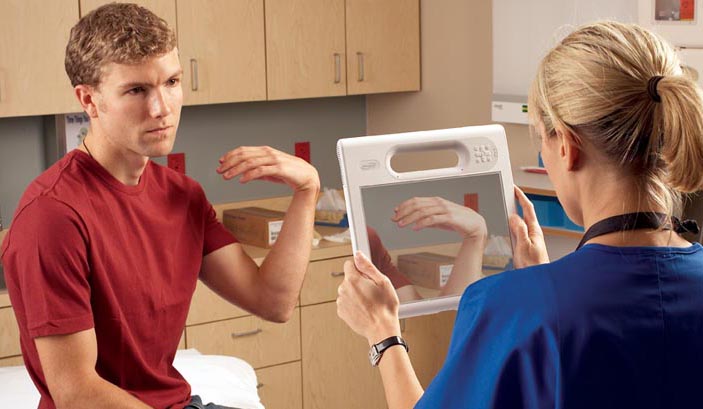
Security
Security is becoming ever more important, and it is certainly a concern in any healthcare setting. To that end, Motion provides user identification in not just one or two ways, but several. It can be done via the barcode scanner, via the RFID reader, or via the built-in fingerprint scanner. And that is in addition to password protection, which extends down to the BIOS level where it can be used to activate or deactivate subsystems in restricted environments. OmniPass software takes care of multiple user identification as well as simple password and access management. Finally, there's the (in)famous Trusted Platform Module for device-level security.
Summary
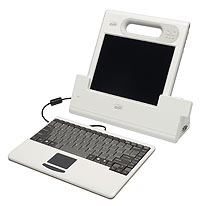 The Motion C5 is an altogether good idea, and it has an awful lot going for itself. It's made by a company that knows the tablet market inside out and has compiled an impressive record of success in vertical markets in a comparatively short time. It's not some experimental technology, but a solid Microsoft/Intel computer using tried and proven technology, and is even able to run Vista. The digitizer provides easy navigation as well as inking and notetaking capabilities. A superior microphone system allows voice capture and dictation. It's equipped with a bundle of security technologies and able to read both RFID tags and barcodes. It offers all the security you'd want. It's specifically built for clinical environments, yet remains light and handy. And the US$2,199 starting price seems on target for what you get, especially since it includes the camera and RFID reader.
The Motion C5 is an altogether good idea, and it has an awful lot going for itself. It's made by a company that knows the tablet market inside out and has compiled an impressive record of success in vertical markets in a comparatively short time. It's not some experimental technology, but a solid Microsoft/Intel computer using tried and proven technology, and is even able to run Vista. The digitizer provides easy navigation as well as inking and notetaking capabilities. A superior microphone system allows voice capture and dictation. It's equipped with a bundle of security technologies and able to read both RFID tags and barcodes. It offers all the security you'd want. It's specifically built for clinical environments, yet remains light and handy. And the US$2,199 starting price seems on target for what you get, especially since it includes the camera and RFID reader.
Motion Computing certainly did its homework when it conceived and then designed the C5. This product is 100% on target and hits all of the characteristics and capabilities one would seek in a healthcare tablet computer.
Update August 5th, 2008: The specsheet of the Motion C5 now shows a 1.2GHz Core 2 Solo U2200 instead of the original Core Solo U1400. Base memory is 1GB instead of 512MB, an 60GB hard disk has replaced the initial choice of a 30 or 60GB drive, and the standard OS is now Vista Business.
– Conrad H. Blickenstorfer
Motion Computing C5 Specs
| Added/changed |
Added 2/20/2007; updated 8/2008
|
| Type |
Semi-Rugged Tablet PC slate
|
| Processor |
Intel Core 2 Solo U2200 1.2GHz, 533MHz FSB |
| OS |
Windows Vista Business or XP Professional Tablet PC Edition |
| Memory |
1GB 533MHz DDR2 expandable to 2GB at purchase |
| Display |
10.4" XGA (1024 x 768) TFT with View Anywhere option |
| Digitizer/Pens |
Wacom/1 |
| Keyboard |
external option |
| Storage |
80 GB 1.8" hard disk; optional Solid State Disk |
| Housing |
Magnesium-alloy internal frame, desinfectant-resistant resin front and lower backplate |
| Temperature |
5-35 degrees Celsius |
| Drop |
3-foot |
| Enclosure Class |
IP-54 |
| Size |
10.0" x 10.0" x 0.95" |
| Weight |
3.3 pounds incl. battery pack |
| Power |
40 WHr Lithium-Ion |
| Communication |
802.11a/b/g via Intel PRO/Wireless 3945ABG module, Bluetooth; optional EV-DO broadband |
| Interface |
2-megapixel camera, Fingerprint Reader, 2 mic, 13.56MHz RFID reader, 13.56MHz RFID HF integrated passive RFID tag, docking connector, optional 1D/2D barcode scanner, optional smart card reader |
| Dock |
10/100 LAN, 3 USB 2.0, VGA, charging bay |
| Price |
starting at US$2,199 |
| Contact |
Motion Computing www.motioncomputing.com |
|



